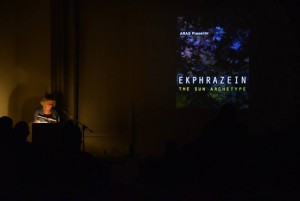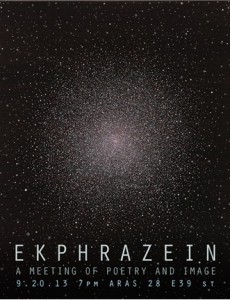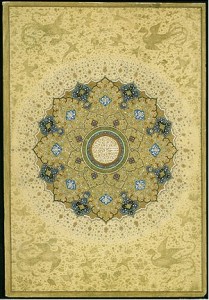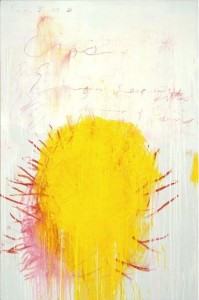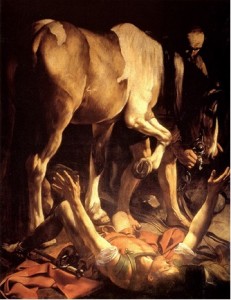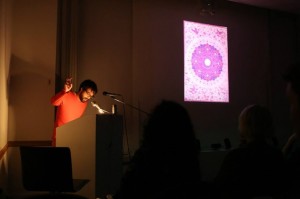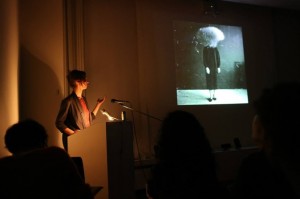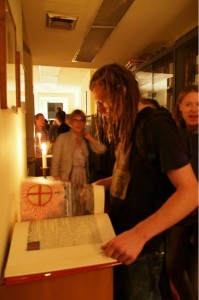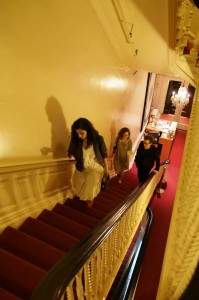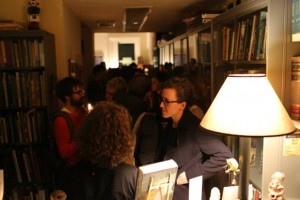Chantal Lee, Rubin Museum Guide, and Giada Shaver, Apprentice Museum Educator at the Rubin Museum, conceived and organized a magical evening of poetry on September 20, 2013, at the C.G. Jung Foundation inspired by ARAS, the Archive for Research in Archetypal Symbolism. Below, Chantal and Giada share their reflections on the power of word and image to inform and transform one another, and the wonders of working at the ARAS archive.
Chantal & Giada: ARAS’ existence as a research archive made itself known to us in true ARAS fashion—through its relationship with other systems of art and thought. For instance, we both knew of The Book of Symbols before we became aware ARAS (Archive for Research in Archetypal Symbolism). Edited and created by ARAS and published by Taschen, the book launch took place at the Rubin Museum in December 2010, although we learned about the Archive much later. The book’s invitation for exploration was obvious; the open and stony hand, flattened on the book cover, beckoned to us like a mudra every time we passed by the Museum shop where it was prominently displayed. And, like a siren, the hand was alluring—it seemed to impress upon us its erudition and depth of research; happily, its encyclopedic contents and beautifully curated imagery did not disappoint. So distracting were its pages that neither of us noticed its fingers nonchalantly pointing to “The Archive for Research in Archetypal Symbolism,” until rediscovering the book much later on the shelves of ARAS when we became volunteers, assisting with cataloging the Archive.
ARAS and the Rubin Museum are in spirit very much alike, though their public roles and specialties are unique. ARAS provides a place for research, uniting through text and image disparate and universal cultural rituals, beliefs, and art production; the Rubin Museum is an arena where world cultures are explored, finding common ground within the artistic and historic traditions of the Himalayan region. The Rubin Museum makes these connections through innovative exhibitions that traverse cultural and conceptual boundaries, as well as through films, lectures and music. Similarly, ARAS embraces the confluence of multiple cultural ideas and images around a single theme.
 This past spring, we were both reintroduced to ARAS by Laura Lombard, Head of Adult and Academic Programs here at the Rubin. In the Archive itself for the first time, we each experienced a feeling not unlike the one that the Rubin had given both of us when we first visited—something akin to falling in love or finding a “heart connection.”
This past spring, we were both reintroduced to ARAS by Laura Lombard, Head of Adult and Academic Programs here at the Rubin. In the Archive itself for the first time, we each experienced a feeling not unlike the one that the Rubin had given both of us when we first visited—something akin to falling in love or finding a “heart connection.”
ARAS comprises over 17,000 archetypal, mythological, and symbolic images, both in its physical Archive and online. Each image is cross-referenced and accompanied by scholarly commentary. Additionally, the Archive is filled with numerous books on artists, archetypal themes, world religions, and cultural practices.
Eager to involve ourselves in the magic that seemed to be occurring in this fascinating, cozy library tucked into the third floor of a brownstone on East 39th Street, we both signed up as volunteers.
Not long afterwards, we began to conceptualize an event at ARAS, Ekphrazein: A Meeting of Poetry and Image to highlight the many poetic ways that a symbol can be artistically understood. We hoped that in the process, these interpretations would become a celebration of art, local community, and the Archive itself. Inspired by ARAS’ existing online poetry forum, Poetry Portal, we embraced the idea of ekphrasis, the age-old practice of using one art form to describe and understand another. We discovered that poetry in response to archetypal imagery provided an exciting outlet for the kind of creative collaboration that both ARAS and the Rubin Museum have consistently encouraged. We were thrilled also to discover that many members of the local poetry community were equally as passionate about this kind of cross-disciplinary approach.
Because this was the first foray into such an encounter, the ARAS staff decided that as an overarching archetypal theme, the Sun would be most appropriate. From there, we chose a series of images related to the Sun that spanned time, culture, and artistic practice. The poets selected images and were given three months to reflect and compose upon them.
Each poet had a very distinct aesthetic, so we were excited to see the range of interpretations produced—some incorporated their own projections, others wrote from personal remembrance, and still others evoked myth and religion. Over one hundred people came on September 20th to the Archive for the event (including many familiar faces from the Rubin!).
To begin the evening, Dr. Rachel Eisendrath, Assistant Professor of English at Barnard College, provided a beautiful introduction to ekphrastic form and legacy. At the reception that followed, we were thrilled to see so many attendees discovering ARAS for the first time, as we once did, as well as the warmth and curiosity that ARAS inspires.
To explore the poetry and works of art from the event , use the links below to view copies of the interpretations:
Conversation on the Way to Damascus by: Robert Whitehead
Exodus by: Sharon Wang
Sun Fog by: Evan Goodman
Parachute by: Todd Anderson



